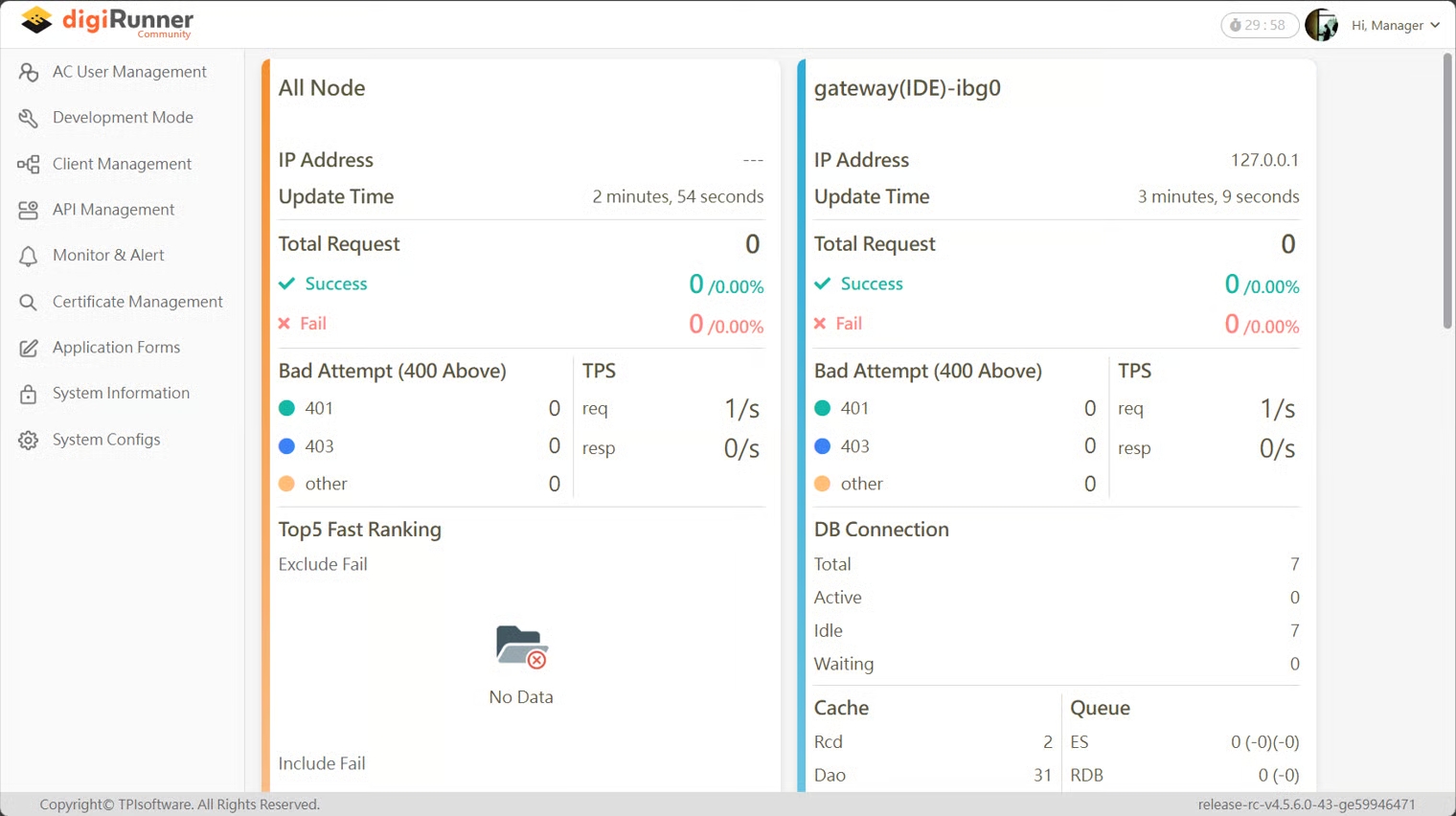Docker compose
digiRunner | Quick Deployment Guide with Docker Compose
This section walks you through deploying the open-source version of digiRunner using Docker Compose.
Prerequisites
Before starting the installation, ensure your host environment meets the following requirements:
Hardware Requirements
CPU: 2 cores or higher
RAM: 4 GB or more
Disk Space: 50 GB or more (excluding the OS)
Software Requirements
Docker - container runtime
Docker Compose - tool to define and run multi-container Docker applications
Official download: https://www.docker.com/products/docker-desktop/
Starting digiRunner with Docker Compose
Download the configuration file, start digiRunner, and preview or modify the file as needed.
Download
Download the Docker Compose YAML file and save it to your computer.
Start the Services
Open a terminal and navigate (
cd) to the directory containing thedocker-compose.ymlfile.Run the following command:
This command will read the docker-compose.yml in the current directory and start all services in the background.
Verification and Login
After deploying digiRunner, verify that all services are running and log in to the admin console.
Check Container Status
Run the following command in the directory containing the
docker-compose.ymlfile:
Make sure the
digirunner-open-source-dgr-1container shows Up (with running time) in theSTATUSfield.
First-Time Login to Admin Console
Open a browser and navigate to one of the following URLs:
Locally:
http://localhost:31080/dgrv4/loginOn a remote server:
http://<your-host-ip>:31080/dgrv4/login
Log in using the default admin credentials:
Username:
managerUser password:
manager123

Upon successful login, you will see the text digiRunner Community displayed in the upper left corner.

Security Tip: After your first login, go to AC User Management > Users and change your password immediately. For details, please refer to SMTP Configuration and Update users.
Management and Maintenance
Use the following commands to manage and maintain digiRunner services.
View logs:
Stop services:
Restart services:
Advanced Configuration: H2 Database Persistence (Important)
By default, the open-source version uses an in-memory H2 database. Consequently, all data, including API configurations and user accounts, will be lost when the container stops or restarts.
To retain data permanently (known as “persistence”), follow the steps below to store the database files on your host machine.
Create a File
Manually create a file named docker-compose.yaml in your preferred project directory.
Add YAML Configuration
Paste the following content into your newly created file:
Explanation of Configuration
Data Persistence : Maps your local
dbfolder to digiRunner’s database path. All changes are saved in real time. Place the folder at the same directory level asdocker-compose.yml.Smart Initialization : Checks whether a
.dbfile exists.On first startup, with an empty
dbfolder, it triggers database creation.On subsequent restarts, with an existing
.dbfile, it prevents reinitialization and preserves the existing data.
Start the Services
Open a terminal, and navigate to the directory containing the
docker-compose.ymlfile.Run the following command:
After the command completes, a db folder will be created containing dgrdb.mv.db, which is your persistent database file.
Troubleshooting
Basic Troubleshooting Steps
If you encounter issues after installing digiRunner, follow these steps:
Step 1. Check Container Status
Run the following command to list all containers, including stopped ones:
Check the
STATUSfield for thetpi-digirunnercontainer. It should display Up. If it shows Exited, a startup failure has occurred.
Step 2. View Logs
If the container is Up but not functioning properly, run the following command to stream real-time logs and identify application-level issues:
Step 3. Restart Container
If the container is unresponsive or needs a reset, run the following commands to restart it:
After restarting, repeat Steps 1 and 2 to verify functionality.
Common Issues to Check
Is Docker installed?
Run
docker infoto confirm.
Is Docker Compose installed?
Run
docker compose versionto confirm.
Backup and Reinstall
If the container continues to crash or logs show critical errors, back up important files, such as config and the database file, delete the faulty containers, and rerun the setup.
Last updated
Was this helpful?
